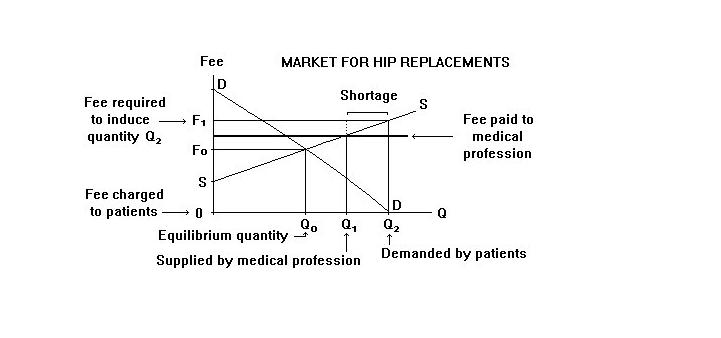
1. because the actual price of medical services is below free market price.
2. because governments refuses to spend enough on medical care.
3. because too many people have hip replacements.
4. for all of the above reasons.
Choose the option that yields the correct answer.
The correct answer is option 4. The fee charged patients for hip replacements is zero---clearly less than the cost and, hence, the free market price. If the government paid doctors and technicians sufficiently, they could be induced to supply the quantity of hip replacements demanded by patients at a zero price. If a service is free there is a tendency for people to use it to excess---it is thus reasonable to conclude that at least some patients would forgo hip replacements if a fee based on income were instituted to partially cover the costs.
The answer can be presented with reference to the Figure below.

The demand curve for hip replacements is DD. The supply curve is SS. When patients are charged a zero fee they demand the quantity Q2. The government would have to pay the medical profession the fee F1 to induce it to produce that quantity. The government in fact pays an amount less than F1, as shown by the thick horizontal line. This induces only the quantity Q1, and a shortage equal to the distance between Q1 and Q2 emerges.
The statement that too many people get hip replacements is a bit controversial. Many would argue that everyone who needs one should get one. The issue turns on what we mean by "need". It would be easy to determine "need" (read that "want") if everyone's income was the same. We could charge the market price and those who were willing to make the financial sacrifice could have their hips replaced. The problem is that peoples' incomes differ and some will be too poor to afford to have a hip replaced. Most people would argue that a person should not be denied a hip replacement on account of low income, though it is fine that they be denied a new car on those grounds. It seems that medical care is somehow different than other goods people consume.
Once we agree that medical care should be available to all regardless of income we encounter the problem of finding a way to bring supply and demand into equality without using the price as a device to ration demand and call forth supply. Setting the payments to medical professionals to call forth the supply that patients will demand at a zero price has tended to result in astronomical medical costs. The reason is that when medical services are free there is no incentive for people to economize on them---doctors will give tests and procedures to patients to make patients feel they are taking action, and protect themselves from criticism if things go wrong, even though the benefits to the patient are clearly less than the cost. This would not happen if patients had to pay the costs of all tests and procedures directly upon use rather than indirectly through their taxes. When these costs are paid for through taxes, the amount each patient pays is largely independent of the amount of medical services used by that patient.
The problem of designing institutional incentives to call forth sufficient quantities of medical services and ration these services among the population without exclusively using price as the motivating force is a challenge that has yet to be met satisfactorily. Economists use the term mechanism design to describe this type of problem.